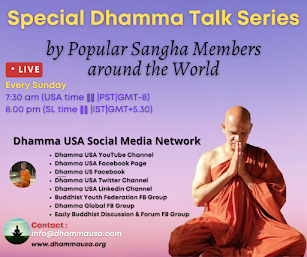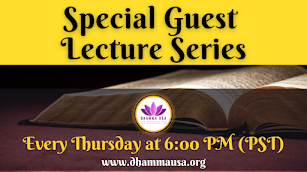Buddhism and Religious Pluralism: Navigating Coexistence and Interfaith Dialogue
By Dr. Nivitigala Sumitta Thero
This essay explores the relationship between Buddhism and religious pluralism, highlighting how Buddhist teachings and practices interact with the principle of coexistence among diverse religious traditions. The Buddha's inclusive approach, as evidenced by his respectful interactions with other religious groups and his encouragement of critical evaluation of teachings, reflects a foundational pluralistic ethos. Historical experiences, including periods of persecution and conflict, such as the destruction of Nalanda University and conflicts in Sri Lanka and Myanmar, illustrate the complexities of maintaining pluralism in practice. Despite these challenges, modern Buddhist leaders like the Dalai Lama advocate for interfaith dialogue and universal compassion, continuing to contribute to a vision of harmonious coexistence. The essay underscores both Buddhism's adaptability to pluralistic values and the ongoing need to address conflicts and promote mutual understanding.
Buddhism, established by Siddhartha Gautama in the 5th to 4th century BCE, has interacted with various religious traditions throughout its history. Its relationship with religious pluralism—a principle advocating the coexistence and respect for multiple religions—has been shaped by both collaborative engagement and periods of conflict. This essay explores Buddhism’s philosophical foundations, historical experiences, and contemporary challenges related to religious pluralism, highlighting the Buddha's interactions with other religious traditions.
The Nature of Buddhism and Its Philosophical Stance on Pluralism
Buddhism's core teachings focus on the Four Noble Truths and the Eightfold Path, which guide adherents toward overcoming suffering through ethical conduct, mental discipline, and wisdom. The Buddha's approach often reflects inclusivity and respect for diverse perspectives. In the Kalama Sutta, the Buddha counsels followers to assess teachings through personal experience rather than mere tradition or authority:
"Come, Kalamas. Do not go by oral tradition, nor by lineage, nor by hearsay, nor by scripture, nor by logic, nor by inference, nor by reasoned thought, nor by the possibility of the existence of a thing, nor by consideration of the speaker, nor by the approval of others, nor by the acceptance of a view." (Kalama Sutta, AN 3.65)¹.
This directive encourages an open-minded and critical approach to religious teachings, aligning with pluralistic values that respect diverse viewpoints and foster dialogue.
Historical Context: The Buddha’s Engagement with Other Religious Traditions
The Buddha's interactions with other religious groups demonstrate his inclusive approach. According to the Pali Canon, the Buddha frequently visited ashrams of various religious traditions. These visits were marked by mutual respect and friendly exchanges. The Buddha’s presence was welcomed, and he encouraged a spirit of noble silence among his followers during these visits:
"When the Blessed One went to the ashram of the ascetics, he would invite them to observe noble silence, explaining that the Blessed One liked it. The ascetics appreciated this gesture, recognizing the Buddha's respect for their practices." (Mahāparinibbāna Sutta, DN 16)².
In dialogues with Brahmins and other religious leaders, the Buddha engaged in respectful discussions, addressing their concerns and sharing his insights. Notable interactions include the Kutadanta Sutta and the Sonadanda Sutta, where the Buddha engaged in philosophical discussions with Brahmins.
In the Kutadanta Sutta, the Buddha discusses the efficacy of ritual sacrifices and the importance of ethical conduct over ritualistic practices:
"The noble disciple should not cling to the mere performance of rituals but should understand the significance of ethical behavior and wisdom as the true essence of practice." (Kutadanta Sutta, DN 5)³.
In the Sonadanda Sutta, the Buddha engages with Sonadanda, a Brahmin, discussing the nature of true nobility and the value of inner qualities over social status:
"It is not by lineage or birth that one is noble, but by one's own actions and the cultivation of virtue and wisdom." (Sonadanda Sutta, DN 4)⁴.
These interactions reflect the Buddha’s willingness to engage in interfaith dialogue and his respect for diverse religious perspectives, reinforcing a pluralistic approach.
Buddhism and Persecution: A Complex History
Despite its inclusive principles, Buddhism has experienced persecution and conflict. In India, the decline of Buddhism was marked by the destruction of Nalanda University by Bakhtiyar Khilji in the 12th century. The university was a major center of Buddhist learning, and its destruction had a profound impact on Buddhist scholarship. Additionally, Hindu rulers sometimes converted Buddhist temples into Hindu shrines and altered Buddha statues to depict Hindu deities, illustrating periods of religious conflict and cultural assimilation.
In Sri Lanka, tensions between the Sinhalese Buddhist majority and Tamil Hindus led to conflict. The destruction of Buddhist temples by invading Indian kings and the subsequent ethnic conflict during the Sri Lankan Civil War further complicated religious pluralism in the region.
Myanmar has seen severe conflicts between the Buddhist majority and Muslim minority, notably the Rohingya crisis, which involved significant violence and human rights abuses. Similarly, in Bangladesh, minority Buddhists have faced persecution, including attacks on temples and forced displacement.
Buddhism in the Modern Context of Religious Pluralism
In contemporary society, Buddhism continues to engage with pluralistic ideals. Modern Buddhist leaders, such as the Dalai Lama, advocate for interfaith dialogue and mutual respect. The Dalai Lama’s teachings emphasize compassion and shared ethical values:
"Just as a mother would protect her only child at the risk of her own life, even so, let him cultivate a boundless heart towards all living beings." (Metta Sutta, SN 1.8)⁵.
This principle of universal compassion reflects a commitment to pluralistic values and promotes a vision of religious coexistence.
Challenges and Tensions
Despite its generally inclusive stance, Buddhism faces challenges in fully realizing pluralistic ideals. Conflicts involving Buddhist-majority societies and religious minorities, such as in Myanmar and Sri Lanka, highlight the complexities of implementing pluralism. These tensions underscore the need for ongoing efforts to address religious and ethnic conflicts while fostering mutual understanding and respect.
Conclusion
Buddhism’s relationship with religious pluralism is characterized by a blend of inclusivity, adaptability, and respect for diverse perspectives. The Buddha’s interactions with other religious traditions, historical experiences of persecution, and modern efforts at interfaith dialogue all contribute to a framework that supports coexistence and understanding. However, the history of religious conflict and ongoing challenges illustrate the complexities of achieving true pluralism. By addressing these issues and promoting dialogue, Buddhism can continue to contribute to a more harmonious global community.
References
"Kalama Sutta." Anguttara Nikaya, 3.65. Translated by Thanissaro Bhikkhu. Accessed August 10, 2024. Access URL.
"Mahāparinibbāna Sutta." Digha Nikaya, 16. Translated by T.W. Rhys Davids and J.E. Carpenter. The Book of the Great Decease. Pali Text Society, 1920.
"Kutadanta Sutta." Digha Nikaya, 5. Translated by T.W. Rhys Davids and J.E. Carpenter. The Long Discourses of the Buddha. Pali Text Society, 1921.
"Sonadanda Sutta." Digha Nikaya, 4. Translated by T.W. Rhys Davids and J.E. Carpenter. The Long Discourses of the Buddha. Pali Text Society, 1921.
"Metta Sutta." Sutta Nipata, 1.8. Translated by Thanissaro Bhikkhu. Accessed August 10, 2024. Access URL.
Rahula, Walpola. What the Buddha Taught. Grove Press, 1974.
Gombrich, Richard F. Theravāda Buddhism: A Social History from Ancient Benares to Modern Colombo. Routledge, 1988.
Lopez, Donald S. Jr. The Story of Buddhism: A Concise Guide to Its History & Teachings. HarperOne, 2001.
Batchelor, Stephen. Buddhism Without Beliefs: A Contemporary Guide to Awakening. Riverhead Books, 1997.
The Dalai Lama. The Art of Happiness. Riverhead Books, 1998.
Harvey, Peter. An Introduction to Buddhism: Teachings, History and Practices. Cambridge University Press, 2013.































0 comments:
Post a Comment
Your comments and feedback are very helpful to us in improving our posts. We really appreciate your time. Thank you!
Dhamma USA Team.